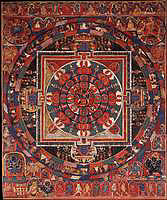
|
Mandala of Tutelary Deity Chakrasamvara (painting no. 97)
|

View Larger Image |
||||||||||||||||
|
Mandala paintings are two dimensional representations of the multidimensional universes Buddhas inhabit. Mandalas are not to be understood as representing someplace different from where we are right now . Rather mandalas display an Enlightened ever present world that is revealed when the dualities of anger, attachment and ignorance are stripped away. Actually these enlightened worlds are constructed of these very same energies that in our dualistic view we perceive as anger, attachment and ignorance but in the unencumbered enlightened state these same defiled emotions manifest as strength, compassion and wisdom. In this sense mandalas are much like architectural blueprints or aerial views of celestial palaces constructed of enlightened concepts. For example, mandalas are usually laid out on a compass like grid; the western quadrant appears red representing the transmutation of desire into discriminating wisdom. This mandala depicts Chakrasamvara ("Wheel of Bliss") in the center of a palace with four gates. Surrounding the palace are various protective cordons ending with a ring of fire. Above we see the teachers of the lineage up to the 14th century. Filling the rest of the space of the painting are various tutelary deities including simplified mandalas of Hevajra (upper left) and Raktayamari (upper right) as well as other protectors and bodhisattvas that were particularly reverred by the Sakya lineage. Basically the painting is a virtual reality of the meditational world of the practioner shown making offerings in the lower left corner. Moke Mokotoff 4-98 CHAKRASAMVARA Sixty-two Deity Mandala (Tibetan: kor lo de chog lha drug chu tsa nyi pa'i kyil kor) from the tradition of the mahasiddha Luipa. Within the center of the two-dimensional circular diagram (mandala) representing the top view of a three-dimensional celestial palace and surroundings is the tutelary deity Chakrasamvara, blue-black in colour, with four faces and twelve hands. In the first pair of hands are a vajra and bell crossed at the heart embracing the consort red Vajrayogini, surrounded by the flames of pristine awareness. Radiating outward are five circles of variously coloured retinue figures. At the top center is the primordial buddha Vajradhara, blue in colour with VajraYogini, red, standing to the left. Further along both sides are the Indian and Tibetan lineage gurus. The circle at the upper left is the Hevajra Mandala; below that is Ratnasambhava-Cakrasamvara. The circle at the upper right is the Rakta Yamari Manadala. Below that is Amitabha-Cakrasamvara and below that a small figure of Sahaja Kalacakra. The large figure at the lower right is Ekavira Vajra Bhairava, drawn in the Gelugpa style, with green Vajravidarana above and Amoghasiddhi-Cakrasamvara to the left, again with a small Shri Devi to that left. The large figure at the lower left is Akshobhyavajra Guhyasamaja with Arapacana Manjushri above, Vairocana-Cakrasamavara to the right, and a small Panjarnatha Mahakala to the right of that. At the bottom left, the small seated figure in the attire of a monk is possibly the sponsor for the painting. To the right is the wealth deity Jambhala, yellow, with one face and two hands. Again to the right is Chaturbhuja Mahakala, black, with one face and four hands - the special protector of the Cakrasamvara Tantras. Further arranged along the bottom are the special Protector Goddesses. The painting style, heavily influenced by Nepali aesthetics and a strong penchant for red, is typical of older Sakya and Ngorpa 'thangkas' and wall murals. Jeff Watt 4-98
|
|||||||||||||||||
Photographed Image Copyright © 1998 Shelley & Donald Rubin Foundation
|
|
| |
Next Image |